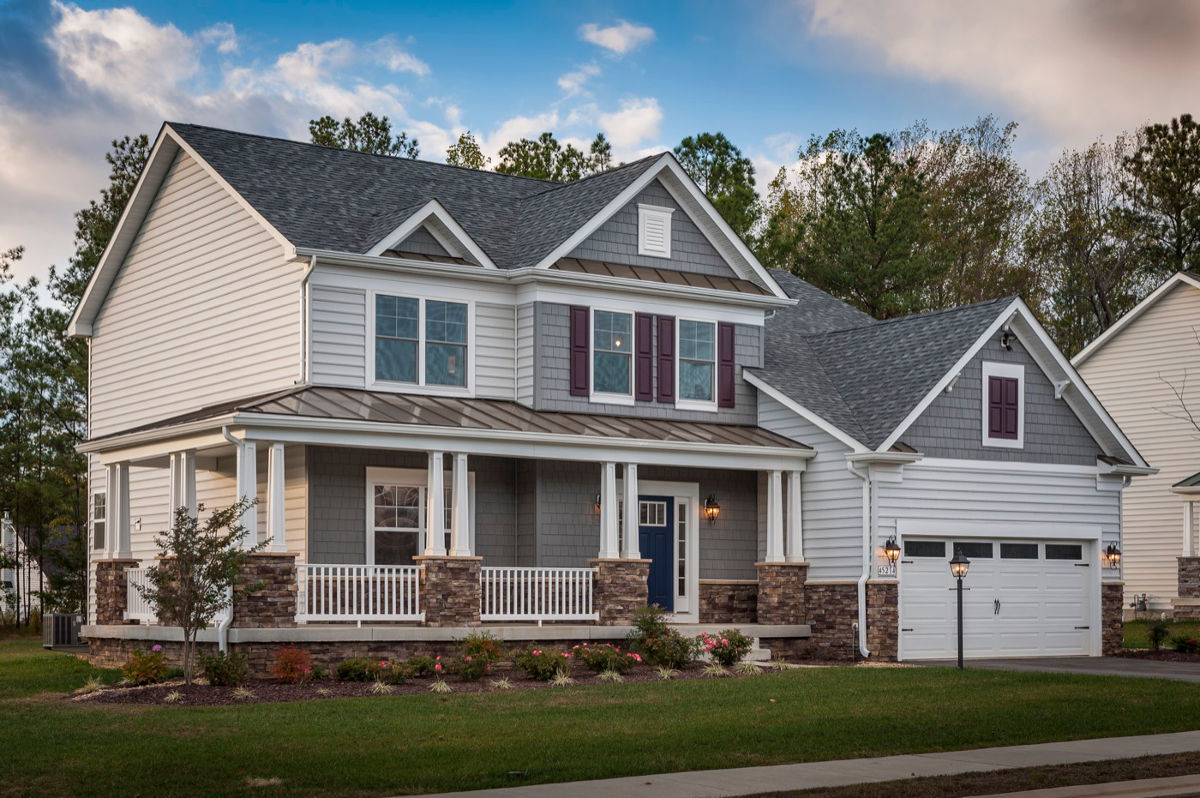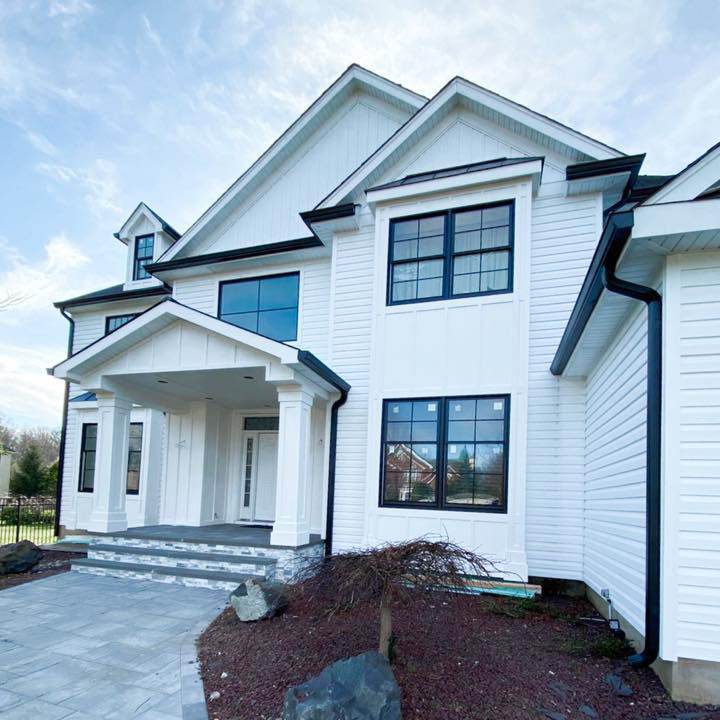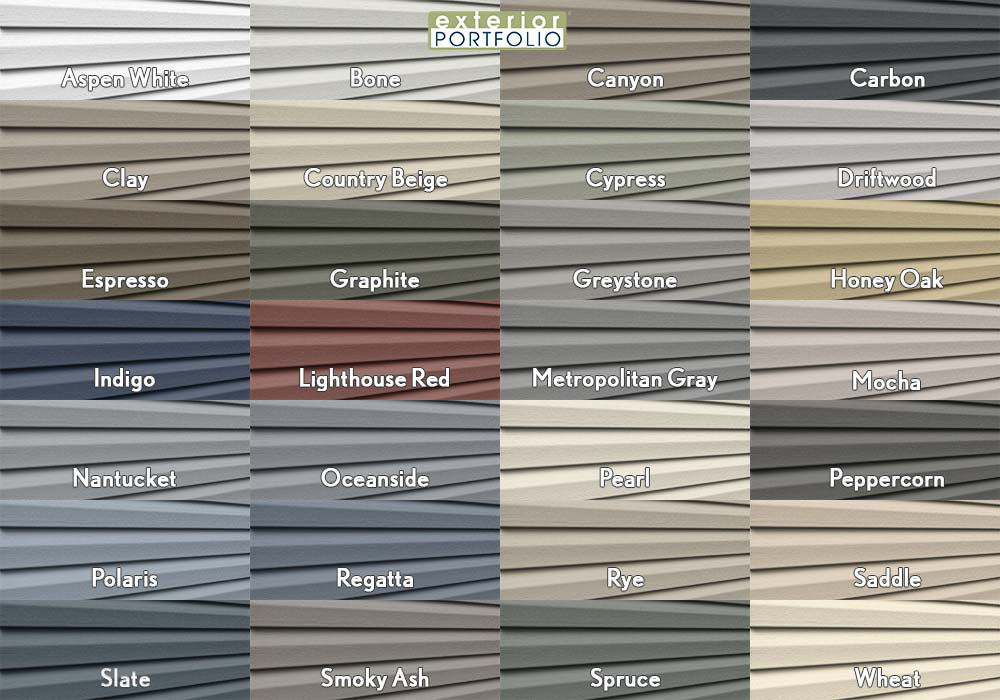If you’re thinking about updating your home’s exterior, you’re not alone – and you’re smart for making such a good investment. According to Remodeling Magazine’s 2021 Cost vs. Value report, “exterior improvement projects [are] continuing a multiyear trend of providing the greatest return on investment (ROI) for homeowners.”
Replacing your siding is one of the most cost-effective ways to increase curb appeal and property value. Learn more …
Whether you plan to install vinyl siding, or update your paintable siding, here are ten tips for picking exterior house colors with confidence.
10 Tips from the Pros
1. FOLLOW A FEW RULES
While you could argue that rules are meant to be broken, most designers stick closely to a tried-and-true principle called the Rule of Three.
Rule of Three
The belief is that the best designs involve no more than three colors (plus black and white, which are technically neutrals), applied in a ratio of 60-30-10. It’s no coincidence that most home exteriors use a combination of three colors – one dominant shade for the main siding, a supporting color for doors, windows and trim, and an accent color to be used sparingly (60-30-10).
Color Wheel Rules
If you’re curious about which colors work together and why, you can explore color wheel rules to create your own contrasting, complementary or monochromatic color schemes.
Rules of Thumb
If all of that feels far too complicated, the team at B&B Siding and Roofing came up with some general rules of thumb to get you started:
- If you have a brown roof, go with beige siding options
- If you have black windows and trim, explore gray siding options
- Use the same accent color for all casing, trim, soffits, fascia and gutters
Use the same accent color for doors and shutters (unless going bold with the front door, then match shutters to trim)
Did you know vinyl siding comes in a wide variety of colors and textures? Explore proven color combinations in our Exterior Portfolio.
It’s important to note that light colors can make a home feel larger, more inviting, and appear visually closer to the street. Although darker colors can make a house visually recede from the curb, they can also make a house feel more substantial, like the home has permanence.
Since we’re on the subject of feelings (yes, we’re going there), let’s talk about how they relate to color and your home. Feng shui practitioners, color psychologists, and color theory experts agree: color affects mood. Although individual tastes vary, there are general truths about color that have been universally accepted – such as warmer reds and oranges are more energizing, and cooler blues and greens are more calming. Before you choose your exterior palette, consider the meaning of individual colors and the mood you want to establish as your home’s all-important first impression.
Putting your House on the Market?
Consider neutral colors that appeal to the broadest range of people possible, and ask your realtor to recommend colors that will help sell your home faster. Avoid bold colors, or too many colors, which may feel like a visual assault to some buyers, and could hurt your sales price.
Updating Your Forever Home?
Choose colors that make you happy every time you pull into the driveway. But make it an overall palette your neighbors can live with, too. Again, you may love bold and bright colors, but consider using them in moderation. The front door is a great place to set the tone of your home, and let your personality shine, through color.
Is your home modern or traditional? Do you live in an urban, wooded or waterfront neighborhood? Is the architectural style Victorian or Brownstone, Craftsman or Colonial, Cape Cod or Split Level? These are all important considerations when choosing your exterior house color palette. For example, a bold near-black body color might look striking on a modern home, but the same color might stick out like a sore thumb in a row of light and bright beach bungalows.
Neighborly Dos and Don’ts
If you belong to a homeowner’s association (HOA), be sure to review and comply with all covenants before updating your home’s exterior. Some HOAs have strict pre-approved color combinations, while others do not. Even if your neighborhood doesn’t have an HOA, it’s good to be aware of established color schemes on your street and to use them as guidance.
Speaking of being neighborly, we do not recommend copying the exact colors of the house right next-door. While some neighbors may view imitation as flattery, many will not. HOAs and other neighbors tend to frown on side-by-side twin color schemes, too.
We added warm contrast to this charcoal roof using custom copper flashing, and the near-black window trim ties into the shingles, brick and stone work.
Another great place to find color guidance is on your home itself. Make a note of the permanent materials you don’t plan to change – fixed elements like roofing, stone, brick, patio decking, and metalwork.
If you’re thinking about replacing your roof, read this first.
Identify Underlying Tones
Then identify the various colors and underlying tones in these materials. Are there cool greens in the stone? A deep purple in the red brick? Warmer yellows or reds in the shingles? Any new exterior colors must either match or complement the undertones of these permanent materials, or the palette simply won’t work.
Here’s an example (right/below) of a home that did it right. The permanent stonework – a tricky mix of cool blues and warmer browns – undoubtedly drove every decision in this exterior house color palette. The crisp white and gray trim offer lighter accents to balance the darker stone. But it’s the way the blue shutters and door pick up the blue tones in the stone that truly pull it all together.
Photo by Jennifer Hughes via hgtv.com
Can Siding be Painted?
Certain siding materials, including wood and stucco, must be repainted every five to ten years, depending on the quality of paint and other variables. Vinyl siding, on the other hand, never needs painting. But if you ever wanted to change the color of your vinyl siding down the road, there are new vinyl-safe paints in a wide range of color options.
Curious about protecting your home with worry-free vinyl siding? Contact B&B Siding and Roofing for a free consultation.
If you’re struggling to come up with color options, try driving around your favorite neighborhoods to find inspiration. Take photos of the color combinations you like, and make a mental note of the palettes that look out of place. Knowing what you like, and what you don’t like, are both equally helpful.
Look at Past Work
If you’re hiring a contractor to install vinyl siding or to paint your home, ask for addresses of current and former job sites. Drive by the projects to see the color combinations in natural light on actual houses, and to gauge the quality of the contractor’s work.
Explore Online Resources
If you’re still feeling stuck, there are countless blogs, social platforms, and digital brochures that are loaded with ideas for house color palettes. Check out the platforms Pinterest and Houzz, websites like HGTV.com and BHG.com, and local contractors, including B&B Siding and Roofing’s inspiration gallery.
Once you’ve found inspiration, it’s time to pick out some colors. First, select a few options for the main color of your home’s siding. Keep in mind that daylight will turn exterior colors lighter, cooler and bluer than they look in the brochure, or on that sample chip you saw in the showroom.
Go Slightly Warmer and Darker Than You Think
For this reason, select sample colors that are two to three times warmer and darker than that color chip you first fell in love with. You might have your heart set on a crisp white farmhouse look, but a true bright white can be blinding in natural sunlight. Don’t be surprised if the white you end up liking best is an off-white called Bone or Pearl.
7. PICK OUT ACCENT COLORS NEXT
With some main body color options in hand, it’s time to pick out a few accent color contenders for your doors and trim.
Tips for Going Monochromatic
If you’re going for a more subtle monochromatic look, pick a trim color just a few shades lighter than the main body color. If you’re painting, a clever designer trick is to choose your main body and accent colors from one single color strip in a paint fan deck.
Whether you seek to express a clean, contemporary look, amplify the elegance of your home style or convey something more traditional, vinyl siding gives you true design flexibility and virtually eliminates the need for maintenance.
If You’re Going High Contrast
Avoid painting high accent colors on less-desirable features, such as a meter box or A/C unit. It’s better to help unattractive elements blend into the background rather than stand out.
How do you know if you picked colors that will look terrific on your house? Read on, color warrior.
8. USE VIRTUAL TOOLS
To help take the guesswork out of pairing body color with accent colors and the fixed elements of your home, consider using an online visualization tool.
Vinyl Siding Preview Tools
Vinyl siding has come a long way in recent years, and offers a wide range of colors and textures to choose from. Using an online visualization tool is a smart way to preview vinyl siding and trim color combinations before you buy. Just upload a photo of your home, or choose a model home in the program, to start mixing and matching colors.
If you plan to paint your home, major brands like Behr, Sherwin Williams and Benjamin Moore offer similar online visualization tools, too.
9. TEST WITH COLOR SAMPLES
Online visualizers may be helpful, but there’s no substitute for seeing the colors on the side of your house.
Vinyl Siding Samples
If you’re going with vinyl, a good siding company will provide vinyl color swatches, and color sample books, for you to test on your home. Place the swatches next to any fixed elements, like brick or stone veneer, and step back to see how they look together. Scrutinize the samples on the north and south sides of the house, in full sun and in shadow, at different times of the day.
Paint Samples
If you’re trying to figure out how to choose exterior paint colors for your house, buy sample-size cans of color in the same exterior finish you plan to use. Try painting colors directly on the siding or on big poster boards. The latter allows you to carry larger samples to different sides of the house, making it easier to visualize if the color is working. Try mixing and matching painted trim and poster boards to find the right color combination.
10. SEEK AN OUTSIDE OPINION
If you still can’t decide on exterior house colors, you can hire a designer, or ask a friend to look at the different color combos with you.
If you’re in the Staten Island, New Jersey, or Brooklyn area, contact the team at B&B Siding and Roofing. Our experienced advisors know the latest color trends, and are skilled at helping people choose exterior home color palettes. B&B Siding and Roofing is the company to trust for your siding, roofing, window, door or gutter replacement needs. Contact us any time for a no-pressure consult. We’re here to help.








